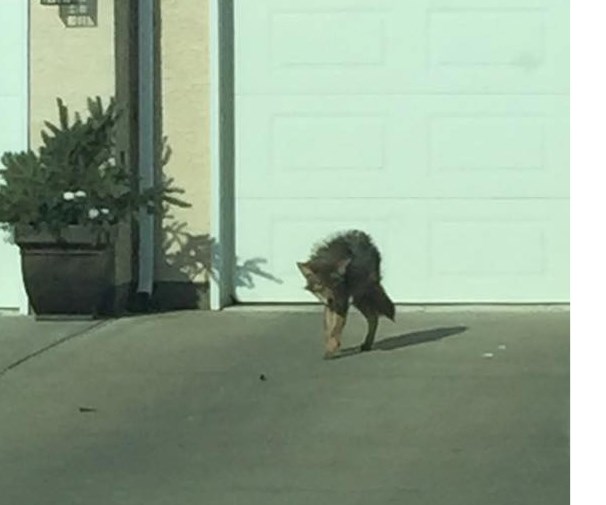While dealing with mangy coyotes and wildlife on an acreage or farm may be part of everyday life, residents within the Town of St. Paul are noticing some rather brave predators coming into their communities.
Jody Looy lives in Spring Creek, on the west side of St. Paul, and noticed animals on her neighbour’s driveway twice in just a few days. On the evening of Nov. 5, she snapped a few photos of a coyote getting close to people’s homes, and on Nov. 9, she snapped more photos, this time in broad daylight, just before lunchtime.
After posting the photos to social media, Looy says other residents commented that they had also seen coyotes within town limits. She contacted the Town of St. Paul bylaw officer to see if anything could be done, and did receive a visit from an officer at her home.
The part that worries Looy is that she has two young children who enjoy playing outside, and the animal she saw on Thursday didn’t look very healthy.
“I shouldn’t be scared to let my kids walk around outside,” but she noted with the animals coming so close to her house, she is hesitant about spending too much time outdoors.
Not sure where to turn, Looy called the Town of St. Paul, and received a visit from Shane Ashdown, with Municipal Enforcement Services. While Ashdown doesn’t have to means to shoot the predators, he did offer the Journal a list of tips that could help prevent encounters.
“Peace officers do not have firearms, and we currently do not trap wild animals in town,” said Ashdown. “Should there be a serious incident, RCMP/Fish and Wildlife would investigate with assistance from (St. Paul Municipal Enforcement.”
Keeping household waste, such as compost, in secured bins is one step, along with avoiding putting meat, dairy and egg products in the compost. It is also recommended to clean up fruit from fallen trees, and anything else that could potentially be food for predators, such as pet food.
Pets should also be taken indoors at night. Coyotes can be territorial and may consider dogs to be a threat.
Motion-sensored lights could also help deter predators from coming too close to houses, because it will scare them. If coyotes are being seen in yards, it is likely because they are attracted to a food source, or a place to make a den.
The list also recommends not letting pets or children play outside, unsupervised, and the list encourages people to be more vigilant at dusk and dawn.
While hunting a coyote in town limits isn’t allowed, the County of St. Paul has reinstated its Coyote/Wolf reduction Incentive Program, as of Nov. 1, 2017. The program will run until March 31, 2018.
Agricultural Service Board staff members accept animal carcasses by appointment only, and the program could come to an end early if budget limitations are reached.
Last year’s bounty program saw 985 coyotes taken in by the County of St. Paul, along with five wolves. The 2015-16 year saw 748 coyotes and nine wolves; in 2014-15 there were 1,602 coyotes and 13 wolves trapped; and in 2013-14 there were 1,361 coyotes and three wolves, according to numbers from Agricultural Fieldman Keith Kornelsen.
The county pays $15 per coyote, and $75 per world, harvested during the Nov. 1 to March 31 period. The incentive could also terminate early if abuse of the program occurs.
Also, the number of coyotes/wolves eligible to be turned in for the incentive payment will be limited to a maximum of 20 coyotes/wolves per week, and a total of 100 coyotes/wolves per resident/landowner. Only one member/resident family is eligible to participate in the incentive program.
“Only whole, unskinned animals are accepted for payment; pelts are not eligible for payment,” reads information from the County of St. Paul. For more information on the coyote/wolf program or to arrange for an appointment, contact Kornelsen at (780) 645-3006.



